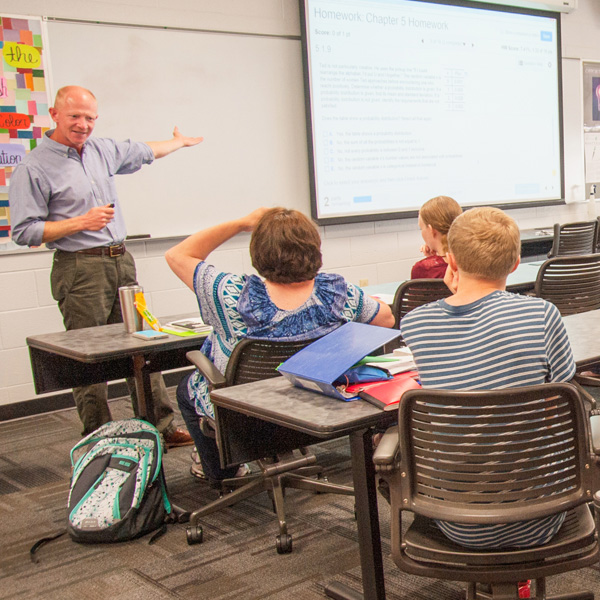Glossary of Terms
A & B
Academic Divisions:
Similar areas of academic paths are divided up into academic divisions. At Columbia State, these include the Health Sciences Division, Humanities and Social Sciences Division, and Science, Technology and Mathematics Division.
Academic Mindset:
Four key beliefs which influence learner behavior and enable success:
- I belong in this learning community.
- I can change my abilities through effort.
- I can succeed.
- This work has value and purpose to my life.
Academic Probation:
A student will be placed on academic probation if the cumulative GPA for all credit hours attempted in any semester is below 2.0. The student will remain on probation as long as the cumulative combined GPA is less than 2.0. Students on probation are eligible to reenroll the next semester but should use that opportunity to earn a GPA of 2.0 during the next semester to avoid suspension. Students on probation should see an advisor before the start of the next semester to determine the best schedule and study practices to increase their GPA the next semester. Advisors often recommend students to repeat classes that were failed but may also advise students to attempt fewer hours and participate in free tutoring.
Academic Status:
Freshman: A student who has completed less that 30 college-level credit hours.
Sophomore: A student who has successfully completed between 30 and 60 college-level credit hours.
Academic Suspension:
Any student on academic probation who fails to attain a 2.0 combined GPA for the next term will be suspended. The first suspension is for one term (not including summer). A second (or more) suspension makes the student ineligible to reenroll for a full year. Students who have served the designated term of suspension will be readmitted to the college on probation with no need to appeal. Students on a first suspension have an opportunity for early readmission. Search the college catalog for Early Readmission for Students on Academic Suspension for additional information on academic suspension appeal.
Accreditation:
Accreditation is a status granted to an educational institution that has been found to meet or exceed stated criteria of educational quality and student achievement. When an institution undergoes the accreditation process, it is judged on a number of established standards and criteria, including its facilities, faculty, programs and student experiences. Accreditation is renewed on a routine basis as long as the institution continues to demonstrate compliance with the standards and commitment to continuous improvement. Learn more about Columbia State's Accreditation.
ACT:
American College Testing. Scores used nationally for placement purposes if not older than five years. To learn more, go to ACT National.
ACT Residual:
American College Testing. Used internally for placement purposes if not older than five years. To learn more, go to ACT Residual.
ACCUPLACER:
Internal placement test. Scores used for placement purposes if not older than five years. To learn more, go to ACCUPLACER.
Add:
The process of adding a class to increase a student's academic course load.
Adjunct Faculty:
Professors who teach on limited term contracts.
Articulation Agreement or Degree Articulation:
A partnership between Columbia State and another institution stating that certain classes will be considered the same or equal between said institutions (includes high school to college agreements). To learn more, go to Articulation Agreements.
Associate Degree (A.A. or A.S.):
The degree typically awarded by a community or junior college following the completion of a two-year program of study or approximately 60 or more credit hours. Most associate degrees provide a general education in math, English, science, etc., which take care of your core requirements, so when you go to a four-year school you will only have two years of education left for your bachelor’s degree.
Associate of Applied Science (A.A.S.) Degree:
The Associate of Applied Science degree is designed for students who plan to enter the job market immediately upon graduation.
Associate of Arts (A.A.) Degree:
Associate degree with a focus on general studies (psychology, history, English, etc.) requiring six hours of a foreign language.
Associate of Science (A.S.) Degree:
Associate degree with a focus on the sciences (physics, biology, engineering, etc.)
Asynchronous Learning:
Asynchronous learning is delivered entirely through a learning management system (LMS). Accessible 24/7, students can log in anytime to review course materials and complete assignments. Students interact with faculty and classmates through discussion boards and group projects.
Business Office:
This is where you will pay bills and fees. This office handles the financial affairs of the college. To learn more, go to Business Office.
C
Catalog
Online book of all the programs and classes offered at your college, as well as academic and student policies. Go to the Catalog.
Certificate (may also be called Technical Certificate):
Shorter term, specific programs that provide you with a credential for a particular skill.
Clinicals:
Clinicals are a series of supervised interactions with patients in local healthcare facilities. Clinicals provide hands-on experiences for nursing students to apply what they've learned in simulation labs.
Course Registration Number (CRN):
The five-digit number assigned to every course that is used to register. EX: 80015 – ENGL 1010, 10342 - SPCH 1010 or 50128 - HIST 2020
Co-requisites or Co-req.:
Courses that must be taken together in the same term.
Course Load or Registration Status:
The number of credit hours in which a student is enrolled during a semester.
- Full-time status = at least 12 credit hours
- Three-quarter time status = at least 9-11 credit hours
- Half-time status = at least 6-8 credit hours
- Less than Half-time status = 1-5 credit hours
Course ID:
The three or four-letter department code that appears before the course number, as in ENGL 1010 or SPCH 1010.
Course Number:
The three or four-digit number designation that appears after the Course ID (department code) and before the section code, as in ENGL 1010 or SPCH 1010.
Course Sequence:
Order in which you need to take your classes (first term, second term, etc.). Course sequence can be found in your program flier.
cPOS:
The course program of study consists of courses needed to complete a degree. Taking courses that do not apply to a student’s degree can cause problems with financial aid, delayed graduation and higher costs. To learn more, go to cPOS.
Credit Hour:
Each credit hour is the value assigned to a course. This value is often equal to the amount of time you will spend in class each week during a semester.
Curriculum (also Paradigm):
Usually refers to the set of knowledge and skills you should gain to fulfill your educational goals for a class, certificate or degree program. May also be referred to as courses required to earn a degree or certificate.
D - G
Dean:
A leader at the college who is in charge of a specific division and manages other college faculty and/or staff. View the Academic Divisions.
Degree Evaluation or Degree Audit:
A checklist of the courses you have earned and the courses you still need to take in order to complete a degree or certificate. Learn how to monitor your academic progress using Degree Works. Log in to myChargerNet to access Degree Works.
Degree Requirements:
A list of exact courses, subject areas and credit hours needed to obtain a specific degree or certificate. To learn more, go to Programs of Study.
Degree Works:
Degree Works is a web-based tracking system that allows students and advisors to monitor academic progress towards program. See also "Degree Evaluation or Degree Audit." Log in to myChargerNet to access Degree Works.
Digital Engagement Initiative (DEI):
Textbook costs can be a barrier to student learning and equitable access. The Tenessee Board of Regents (TBR) launched the Digital Engagement Initiative to offer electronic course materials in an effort to reduce course material costs for students, make materials available on day 1 of class, and employ digital textbook options to maximize student learning.
Disbursement or Distribution:
When financial aid funds are given to students. To learn more, go to the Academic Calendar.
Drop:
The process of decreasing an academic course load. Students should speak with an advisor before dropping a class to ensure that this will not affect financial aid. To learn more, go to Dropping a Class.
Dual Credit:
Dual credit provides an opportunity for high school students to take college credit–bearing courses taught by college-approved high school teachers. The college in a dual-credit program reviews and approves high school instructors to teach college syllabi in their classrooms. Dual credit courses taken count toward graduation from high school and also count as college courses that will appear on a transcript once students begin undergraduate studies.
Dual Enrollment:
Dual enrollment, also referred to as concurrent enrollment, is the practice of allowing a student to be enrolled in two academic institutions at once. The term is most prevalently used in reference to high school students taking college courses while they are still enrolled in a secondary school. The credits earned apply both to high school diploma requirements and college graduation requisites.
EFC:
Your Expected Family Contribution (EFC) is an index number used to determine your eligibility for federal student financial aid. This number results from the financial information you provide in your Free Application for Federal Student Aid (FAFSA®) form. It's reported to you on your Student Aid Report (SAR). To learn more, go to EFC.
Electives:
College-level courses in which a student may enroll, depending upon his or her interests and needs. When choosing electives, students should consult an advisor.
FAFSA®:
Free Application for Federal Student Aid. The FAFSA® is the official form that families must use to apply for federal financial aid to pay for college. It is also used by many states, individual colleges and universities in making their financial aid decisions. To learn more, go to FAFSA®.
Fees:
Fees are charged in addition to tuition to cover specific costs such as technology or specialized course fees, including internet courses or classes that require special materials or instruction. (Example: Engineering, Nursing, etc.) To learn more, go to Tuition & Fees.
First-semester Freshman:
A student in their first semester who has earned less than 12 hours.
Freshman:
A student who has completed less than 30 credit hours.
Full-time Student:
A student enrolled in 12 or more credit hours during a semester.
General Education Requirements:
Specific courses that will provide all degree-seeking students with a broad knowledge in a variety of disciplines.
Grade Point Average (GPA):
Indicates a student's academic progress and status on a 4.0 scale.
Grant:
See scholarship.
H - Q
Health Sciences Division:
The Division of Health Sciences offers programs in health care careers that prepare students for entry-level positions.
Humanities and Social Sciences (HASS) Division:
The Humanities and Social Sciences Division offers a wide array of courses dealing with human behavior and interaction in social, cultural, environmental, and political contexts, including psychology, sociology, education, music, art, theatre, education, earth science, political science, and more.
Learning Support Courses:
Classes (math, reading or writing) required based on placement scores that are taken in your first terms concurrently with the college-level classes. To learn more, go to Learning Support.
Loan:
Borrowed money that you will need to repay gradually over time. This amount will accrue interest therefore the amount you repay will be more than the amount you borrowed. To learn more, go to Loans.
M-T-W-R-F-S-U:
Days of the week: M = Monday, T = Tuesday, W = Wednesday, R = Thursday, F = Friday, S = Saturday, U = Sunday
Online Campus:
Online Campus is the online portal for students to access their online Columbia State courses. Students enrolled in livestreaming or in-person classes should also check to see if course materials are posted in Online Campus.
Part-time Student:
A student enrolled in less than 12 credit hours during a semester.
PELL (Federal PELL Grant):
Federal money awarded to a qualifying student that does not have to be paid back. To learn more, go to PELL Grant.
Placement Tests:
Results of the ACT, SAT, ACCUPLACER exam tests are used to place students at the appropriate entry level with respect to reading, writing and mathematical skills. The scores are good for five years. To learn more, go to Testing Services.
Pre-requisite(s) or Pre-req.:
Course(s) you must complete before taking another course. You will not be able to register for a more advanced course unless the pre-requisite is completed.
President:
The chief administrative officer at the college. To learn more, visit President's Welcome.
Program Director:
A full-time faculty member who oversees an A.A.S. degree or technical certificate program.
Program of Study:
This is commonly referred to as your major. It is the focused area of your studies, such as business or history. This is what your degree or technical certificate will be in when you graduate. To learn more, go to Academic Programs.
PVT, PVT username and password:
PVT is the name of the "private" domain used at Columbia State. Your username is assigned upon acceptance to the college. This is the username and password that you will use to access all of your Columbia State applications such as myChargerNet, email and Online Campus. Having issues logging in? Visit Information Technology.
Quality Hours:
Credits earned which affect a student's grade point average.
Quality Points:
The number of quality hours (for a course) multiplied by the numerical value of the grade earned (A = 4.0 points, B = 3.0 points, etc.). The total number of quality points divided by the total number of quality hours equals a student's cumulative grade point average.
R - S
Refund:
Monies returned to the student for (1) overpayment of fees and/or tuition (2) a prorated amount of tuition and/or fees received upon dropping a course or withdrawing from all courses or (3) financial aid monies awarded to the student exceeding the amount of tuition and/or fees charged to the student for enrollment in a particular semester. For overpayments, the payments are reimbursed to the payment method(s) that was used by the payer. For excess aid, the student has the choice of ACH (direct deposit) refund or mailed check. If a direct deposit refund account is not set up, the refund will default to a mailed check. Direct deposit refunds allow the student to receive the monies in a more timely manner. For more information on how to sign up for direct deposit please go to Set Up Direct Deposit.
SAT:
Scholastic Aptitude Test. Scores used for placement purposes if not older than five years. To learn more, go to SAT.
Satisfactory Academic Progress (SAP) Appeal:
When a student has a Maximum Timeframe Violation by attempting more than 150% of the hours required for graduation without receiving a degree or working on a second degree and have exceeded 150% of the hours required for graduation, the form must be submitted along with a written statement explaining why the violation has occurred. To learn more, go to SAP Reviews and Appeals.
Scholarship:
Free money for your college costs. Generally given to specific groups of students based on achievement, volunteer work, need, or other characteristics (ethnicity, hometown or county, program of study, athletics, etc.). For more information, go to Scholarships.
Section Code:
The 1-3 letters that appear after the Course ID and course number in the schedule that denotes the location of a course, as in ENGL 1010 C01, SPCH 1010 L01 or BUS 120 C91. (Example: C = Columbia Campus, L = Lawrence Campus, F = Williamson Campus, M = Lewisburg Campus, W = Clifton Campus)
Semester:
Period of instruction generally 15 weeks in length. Columbia State offers fall, spring and summer semesters.
Sophomore:
A student who has successfully completed at least 30 hours but has not yet completed their degree or certificate.
Science, Technology and Mathematics (STM) Division:
The Division of Science, Technology and Mathematics offers an array of programs, including biology, computer science, engineering, marketing, pre-health professions and more.
Student Aid Report (SAR):
The Student Aid Report summarizes the information you reported on your Free Application for Federal Student Aid (FAFSA). It includes your Expected Family Contribution (EFC).
Syllabus:
An overview of a particular class. May include key assignments, due dates, course description and learning goals, etc.
T - V
Term:
Period of time in which classes are offered. Columbia State offers 15 week, 10 week, 7 week and 5 week terms.
TN eCampus previously known as RODP (Regents Online Degree Program):
Collaboration between the Tennessee Board of Regents colleges of applied technology, community colleges, and universities to offer certain courses online. To learn more, go to TN eCampus.
TN HOPE Scholarship:
Scholarship awarded to Tennessee residents that have met a high-level academic criteria; students may attend a community college or university. To learn more, go to TN HOPE Scholarship.
Tennessee Promise:
A last-dollar scholarship, meaning the Tennessee Promise will cover tuition and fees not covered by the Pell Grant, the HOPE scholarship, or TSAA funds. Students may use the scholarship at any of the state’s community colleges, TCATs, or other eligible institutions offering an associate degree or certificate program. To learn more, go to Tennessee Promise.
Tennessee Reconnect:
A last-dollar scholarship for any qualifying adult in Tennessee to attend or reenter college tuition free. To learn more, go to Tennessee Reconnect.
Transcripts:
Written record of a student's academic performance. Students may obtain an unofficial transcript from his/her myChargerNet account. An official transcript can be requested online or by submitting a Transcript Request Form to the Office of Records. To learn more, go to Transcripts.
Transfer:
An academic program designed primarily to enable students to enter the third year of a baccalaureate program at a four-year college or university. To learn more, go to Transfer Information.
Tuition:
The charges assessed for each credit hour in which a student may register. To learn more, go to Tuition and Fees.
Vice President of Academic Affairs:
One of the chief administrators at a college; manages all academic programs and academic strategies.
W - Z
Withdrawal:
The process of dropping out of a course, program of study or leaving the college. Students that properly withdraw will receive a “W”; this does not affect the GPA. Students who do not follow the proper withdrawal procedures may receive a grade of "F"; this does negatively affect the GPA and may negatively affect financial aid and scholarships.







